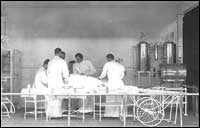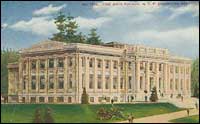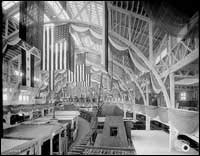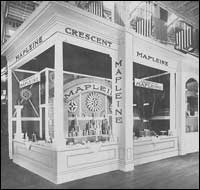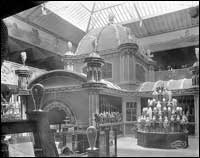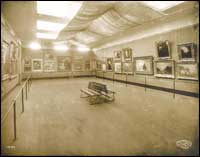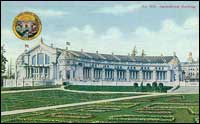|
ExhibitsExhibits were a major attraction of the AYP and featured in most of the buildings on the Fairgrounds. Intended to be educational, exhibits were used to show off the products, people, and culture of the sponsoring country, state, county or organization. Content ranged from the world's largest book to 1.4 million dollars worth of Alaskan gold. Some of the most impressive exhibits were in the U.S. Government, Agriculture, and California Buildings. Rules for exhibits for all types of exhibitors, from businesses to governments, were outlined in the Rules book. The exhibits in the U.S Government buildings contained materials mainly from different departments of the government or from the state or territory featured in a specific building. The Smithsonian Institution was responsible for providing many of the exhibits, some of which traveled from one exposition to another across the nation without being unpacked in between. Some of the exhibits featured in the U.S. Government buildings included the U.S. Military Academy display, the Navy exhibit under a 270’ high dome, the Post Office exhibit with figures of Pony Express mail carriers, and a Marine hospital service operating room showing a surgery. The Agriculture Building featured 60,000 square feet of exhibit space for displaying Washington State's fruits, vegetables, and natural products. It included educational exhibits from Washington counties, schools, and universities, daily demonstrations of food products, women's handiwork, and display areas for counties that did not have their own buildings. These displays were considered sophisticated for the time, and several were designed by local architects. The Education Building contained exhibits from state schools, operated a model school in session daily, and housed a kitchen, carpentry shop, and dining area for the Olympia High School Domestic Science program's demonstrations and catered luncheons. One state that showed particularly spectacular exhibits was California. These imaginative displays included a lemon made of lemons, an elephant of walnuts, a cow of almonds, and a large domed structure in the middle of the exhibit. The galleries in the Fine Arts Building contained Barbizon paintings and the works of Old Masters as well as works by early English, early American, and contemporary artists. The entire third floor was devoted to the Native American photographs of Seattle photographer Edward S. Curtis. The Fine Arts Building, today Architecture Hall, is one of the few buildings from the AYP that remain today. Items from other institutions:
|



